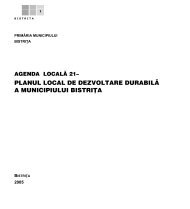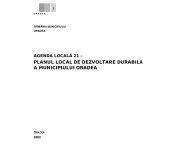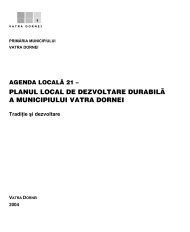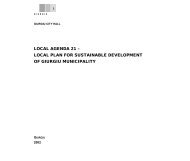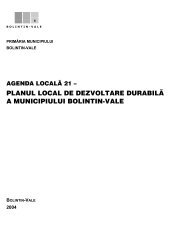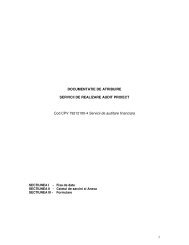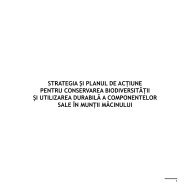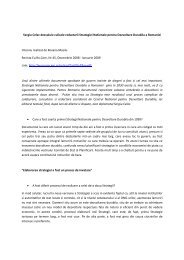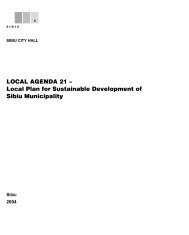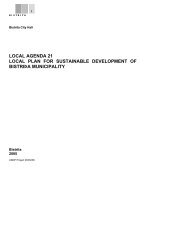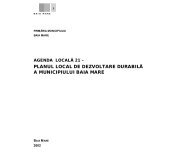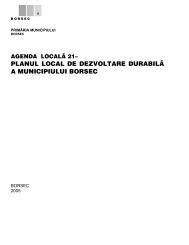English Version - United Nations Development Programme Romania
English Version - United Nations Development Programme Romania
English Version - United Nations Development Programme Romania
Create successful ePaper yourself
Turn your PDF publications into a flip-book with our unique Google optimized e-Paper software.
The Danube and the Danube Delta<br />
With more than 1,000 km along an in the <strong>Romania</strong>n territory, the Danube, together with its overflow<br />
meadows and delta, has always represented an important part of our natural capital. As a result of the human<br />
activity upstream and in <strong>Romania</strong> (which has 97.8% of its territory in the Danubian basin), changes have<br />
occurred in the hydrologic regime as well as in the quality of water. These have had a negative influence on the<br />
ecosystems found in the Delta and on the north-western coast of the Black Sea.<br />
The embankment works executed in the 60s on approx. 800 km along the <strong>Romania</strong>n border in order to<br />
obtain new land, have practically led to the disappearance of the flooding areas. As it happens in large systems,<br />
the ensuing effects appeared much later and were obviated by<br />
eutrophication of Danube Delta waters, and partly of those in the north-west Black Sea, due to the<br />
elimination of the filtering effect caused by intensive agriculture and non-filtered streams from towns along<br />
the rivers (possible only in the presence of the flooding areas);<br />
changes in the specific diversity of fish and the dramatic decrease in fish populations with great economic<br />
value (especially carp), due to a lack of shallow water zones in the flooding areas, which is needed for their<br />
reproduction.<br />
Another factor whose detrimental effects were not initially considered, has been the building of dams<br />
and water reservoirs for the electric power supplies. Their appearance has led to changes in the flood patterns<br />
and to a fall in the quantity of alluvia carried by the Danube, due to water decantation. It has also caused major<br />
distortions in the <strong>Romania</strong>n coastal ecosystems. Another effect caused by dams was the disruption of migration<br />
paths for the reproduction of valuable sturgeon species.<br />
The Danube Delta is the largest humid zone in Europe. The diversified structure of the natural<br />
ecosystems, most of which were unaffected by human activity, have made the Danube Delta, together with the<br />
Razelm-Sinoe lagoon complex, a Biosphere Reserve. It has also been included on the list of International<br />
Natural and Cultural Heritage, and in the Ramsar Convention. As a direct effect of the flooding areas<br />
disappearance, the Danube Delta's capacity to retain nutrients has increased sharply since the 80s. It is currently<br />
affected by eutrofication, which has led to the reduction or loss of low water macrophitae, to changes in the<br />
range of periphitic and epiphytic algae, and to the spreading of rival species favoured by the nutrients in excess<br />
(for example, the blue-green algae).<br />
Apart from the losses caused by eutrofication, the Delta’s biodiversity was and still is affected by the<br />
changes in or destruction of the habitats, by changes in the hydrological patterns. The latter are due to the<br />
creation of man-made channels or meander interruption, by transforming large areas into agricultural or fishing<br />
zones, or by the change in water quality (transformation of the Razelm lagoon into a fresh water lake).<br />
4.6 Forests and Forestry<br />
In 1998, the forest fund of <strong>Romania</strong> included 6.37 million hectares (i.e. 26.7% of the whole area)<br />
of which 6,23 million hectares are covered by forests. Most of the forests are state owned, with only<br />
336,000 hectares in private ownership. The process of retrocession to the former owners is under way in<br />
the case of other forested areas.<br />
The estimated volume of timber is 1.37 billion m³, with an average of current growth of 5.6 m³<br />
and an average volume per hectare of 215 m³. From this point of view <strong>Romania</strong> takes a leading place in<br />
Europe but, as a result of unsustainable forestry policy, it suffered a gradual setback and was surpassed by<br />
many European countries that secured better conditions for a sustainable development of their forests.<br />
Other indices of the forestry resources are shown in Table 4.3 and several conclusions may be<br />
drawn:<br />
There is a relatively low economic potential of the forests, with the normal volume of timber<br />
being of about 16 million m³ in 1998, as compared to 21 million m³ four decades ago;<br />
Reduced accessibility to the forestry fund, the density of forest roads being of 6.2 m/ha;<br />
Forests pay an important ecological role of protecting the environment; that is why approximately<br />
50% of <strong>Romania</strong>’s forests can be included in this category (protecting water resources, soil,<br />
climate and the ecological and genetic funds).<br />
Owing to the great capacity to metabolise carbon dioxide and to store it into the biomass and<br />
black mould humus, the forests of <strong>Romania</strong> are a redoubtable anti-enthropic barrier, creating<br />
favourable effects well beyond the national frontiers. For example, in <strong>Romania</strong> the ratio between the<br />
CO 2 emissions and the adsorption of the gas by forests is much lower than that registered in other<br />
European countries like Germany, Great Britain, Switzerland, etc.<br />
A rich and varied hunting fauna comes to crown the forestry heritage of <strong>Romania</strong> (stag – 30,000;<br />
roebuck – 150,000; bear – 5,500; wolf – 3,000 heads).<br />
Despite the fact that the forests take only 26.7% of the area, this figure is very close to the<br />
international standard, 25%.<br />
32



